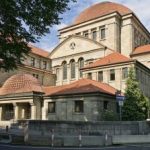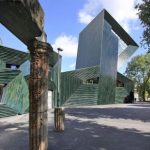
This article, originally posted by forward.com, is sponsored by the German National Tourist board.
Before World War II, there were about 2,800 synagogues in Germany. Now there are around 130. It’s a grim statistic, but there is cause for optimism. Since reunification, Germans have had a renewed interest in the Jewish history of their country. They’ve also welcomed an influx of Jews, mainly from the former Soviet Union. Thus many of today’s synagogues are new, and the older ones are often beautifully restored. Together they demonstrate the breadth and diversity of German-Jewish architecture. Here’s just a few of Germany’s unique synagogues waiting to be visited.
Berlin – The New Synagogue
Everybody knows that Berlin is hip. What’s less discussed is the importance the Berlin holds in the long history of German Jewry. A prime example is the Moorish pomp of the New Synagogue, which evinces of the renewed attention to Jewish life in Germany, both past and present. Built in 1866, the synagogue managed to make it through the Holocaust and Allied bombing raids of World War II — but not without major damage. As with other German sites of Jewish interest, the New Synagogue’s restoration effort began in the 90s, culminating in its re-dedication in 1995.

Frankfurt – The Westend Synagogue
This thriving city boasts a number of sites of Jewish interest. One of the most interesting is the Westend synagogue. It’s an early 20-century building inspired by ancient Egyptian and Assyrian architecture. The main sanctuary is striking, richly ornamented in blue and gold. The synagogue is currently used by an Orthodox community.

Mainz – The New Synagogue
In the Middle Ages, Mainz was an important center of Jewish learning. The Jewish Community Center of Mainz celebrates the city’s Jewish past — and present — with its striking collisions of geometric forms. Its cladding, ceramic tiles with transparent green glazing, lighten and soften the sharp angles of the building. The architects purposely surrounded the center with public space in order to emphasize its connection to the city, creating a kind of living sculpture.
For more travel information, click here.